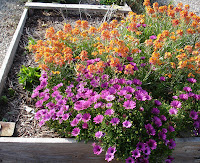 To name a few: the soil in the planting bins heats up earlier in the season than the ground does, the soil doesn't get compacted from walking on, the soil drains well, planting and harvesting of herbs, vegetables or flowers from bins is easier because you don't have to bend over as far, underground varmints can't eat the roots, and there is less damage to young seedlings by crawling insects, slugs or snails.
To name a few: the soil in the planting bins heats up earlier in the season than the ground does, the soil doesn't get compacted from walking on, the soil drains well, planting and harvesting of herbs, vegetables or flowers from bins is easier because you don't have to bend over as far, underground varmints can't eat the roots, and there is less damage to young seedlings by crawling insects, slugs or snails. The photo on the right shows our row of bins. This time of year the bins don't look like much because the plants are so small, but wait a month or two and you won't be able to see the bins at all due to the size of the plants. I have alyssum planted in the center of the bins to help attract bees for pollination. We constructed our bins from recycled lumber. There was a corral behind our barn and since we weren't going to have cows or horses we tore the corral down and used the posts and boards for our bins, our grape support system and our wisteria arbor. Recycled lumber can be found most any place, even old doors can be used. I would not recommend using treated lumber or railroad ties for vegetables bins as chemicals used in the wood may leach into the soil and be taken up by the plants.
The photo on the right shows our row of bins. This time of year the bins don't look like much because the plants are so small, but wait a month or two and you won't be able to see the bins at all due to the size of the plants. I have alyssum planted in the center of the bins to help attract bees for pollination. We constructed our bins from recycled lumber. There was a corral behind our barn and since we weren't going to have cows or horses we tore the corral down and used the posts and boards for our bins, our grape support system and our wisteria arbor. Recycled lumber can be found most any place, even old doors can be used. I would not recommend using treated lumber or railroad ties for vegetables bins as chemicals used in the wood may leach into the soil and be taken up by the plants.Since we have lots of gophers here, we placed aviary wire on the bottom of each bin so gophers could not burrow up from the ground. Then we placed the boards on top of the soil and screwed 4x4 posts inside each corner for support. The bins are 12 feet long x 2.5 feet wide and 20 inches tall. The lumber we had happened to be 12 feet long so we just kept it to that dimension We mixed native soil with about a third compost and placed this in the bins, watered them well and if the mixture settled, we added some more, keeping it about two inches below the top.
 To the left you see my pepper bin, smaller than the other bins. I use baskets for my tomatoes, peppers and flowers to keep the wind from blowing them over. In each bin, we placed ground cover cloth over the top of the soil. We cut X's in the cloth every two feet and that's where we plant the vegetables, herbs or flowers. The less soil exposed, the less weeding we have to do. We have placed bark on top of the ground cover cloth. Both the ground cover cloth and the bark help to retain moisture in the summer months. I rotate my vegetables to different bins each year as each plant requires different nutrients. This will be the fourth year for the wood bins and they are still holding up.
To the left you see my pepper bin, smaller than the other bins. I use baskets for my tomatoes, peppers and flowers to keep the wind from blowing them over. In each bin, we placed ground cover cloth over the top of the soil. We cut X's in the cloth every two feet and that's where we plant the vegetables, herbs or flowers. The less soil exposed, the less weeding we have to do. We have placed bark on top of the ground cover cloth. Both the ground cover cloth and the bark help to retain moisture in the summer months. I rotate my vegetables to different bins each year as each plant requires different nutrients. This will be the fourth year for the wood bins and they are still holding up.If you can afford the cost, I recommend building bins from cinder blocks. The advantage of cinder block is they don't rot like wood does and the hollow space in the center of the block is an insulator for the soil. When we lived in Arkansas we made bins from cinder blocks with a block top cap. We could sit on the top cap to harvest our herbs, vegetables and flowers. We did not use mortar to build them, so if we ever wanted to move the bins, we could just take the cinder blocks down. We placed the cinder blocks four high and overlapped the seams. We made the block bins about 4 foot square.
With a little effort and time, you can construct your own bins, even in a limited planting area, and reap the rewards of your harvest.




